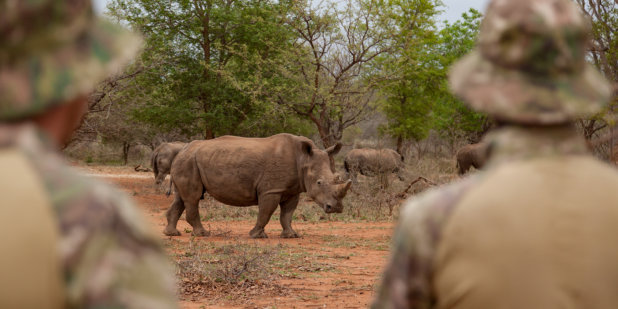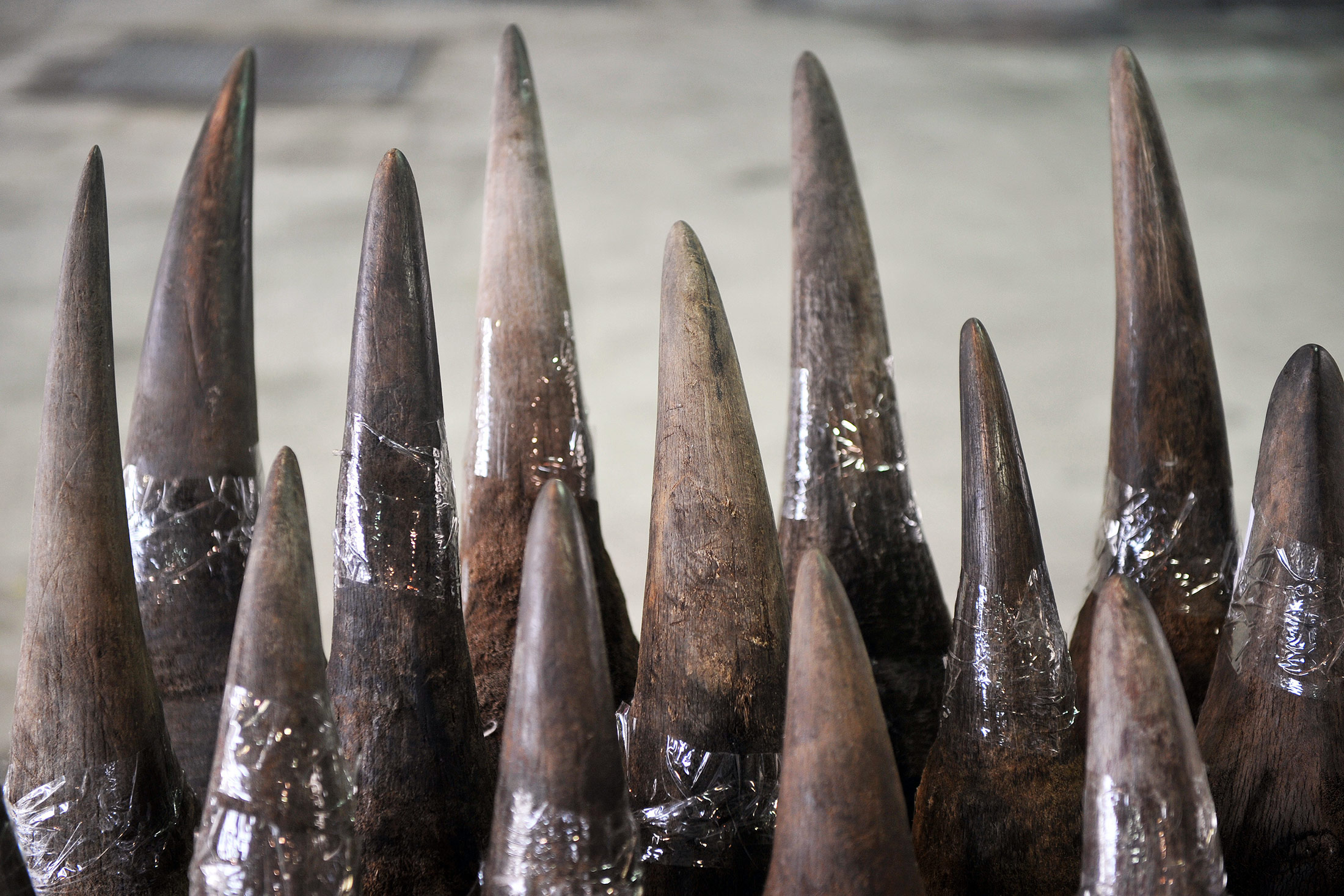- About
- Topics
- Picks
- Audio
- Story
- In-Depth
- Opinion
- News
- Donate
- Signup for our newsletterOur Editors' Best Picks.Send
Read, Debate: Engage.
Africa's rhino poaching problem is multifaceted. The interplay of its demand and supply side is fueled by poverty, greed, superstition, corruption, social injustice, ruthlessness and ignorance.
As the demand is mainly originated in Vietnam and China, wildlife crime is controlled by international syndicates. These syndicates are the reason for the significant increase in rhino poaching in Africa since 2007, putting pressure on anti-poaching rangers. Although there are also other factors such as climate change and the expansion of human habitat, the organised killing and selling of horn in Asia is the driving factor why conservation of wildlife, in particular, the protection of rhinos have become a fight against crime and race against time, if we are to save the rhinos.
For that, we're looking into the structure of organised poaching. One investigative source is Al Jazeera's documentary “The Poacher's Pipeline“ which is based on undercover research carried out in November 2016. In it, they unfold a rare inside view of the structure of the syndicates that are behind the current rhino poaching crisis in Africa and Asia.
FAIRPLANET spoke with Vince Barkas and Sarah Stoner about the complexity of the poaching problem and trafficking of rhino horn, examining the findings of Al Jazeera's research.
Barkas is a South African an entrepreneur with a military background who founded ProTrack, a private anti-poaching unit operating mainly around Kruger National Park in South Africa closely collaborating with Hemmersbach Rhino Force.
Stoner is senior intel analyst at the Wildlife Justice Commission (WJC), a NGO based in the Netherlands, which describes its mission to help disrupt transnational, organised wildlife crime by exposing criminal networks and the corruption that enables them to flourish by empowering – or, if need be, pressuring – governments to enforce their laws.
How is the structure of the supply-and-demand-chain between Africa and Asia? What does the 'Poacher's Pipeline' look like from your perspective?
VINCE BARKAS: “For giving a brief overview of the situation, that structure is fine. However, if you're on the ground to tackling those syndicates things get a little more complicated, of course.
At Kruger Park, for example, you're in an environment of different types of poachers. You've got the – let's say – big game poachers, with the rhino currently being their main target. This is indeed pretty much controlled by the big syndicates. But at the same time, you have a lot of meat poaching as well. Meat poachers basically hunt in order to feed themselves and their families and to sell some meat at the local markets to make a living. They usually go for Impala or kudu or those kinds of animals. Most of them are not involved in rhino poaching, although they might have a certain knowledge of the terrain and the local settings.“
So, at Greater Kruger Park you're presumably dealing with level 1 and 2 of the poacher's pipeline?
VINCE BARKAS: “That's right. At level 1 for instance, you usually have a team of two or three poachers, sometimes more, some of them are trackers or putting up snares, some guards, others work as drivers and so on. Some of these groups are exceptionally well equipped, not only in terms of guns but also high tech gadgetry. We recently found quite modern night vision goggles in a bag a poacher threw away when we went after him.“
Is it a phenomenon of the poor in the local communities around the National Park?
VINCE BARKAS: “Most of the poachers come from communities that are directly adjacent to the Greater Kruger, but not only on the South African side. Many poachers come from Mozambique. Since today, the border of the Kruger to Mozambique is somewhat better guarded, they now try to bypass the Kruger and get in from the west, at the private game reserves, which adjoin the Kruger national park and conjointly form the Greater Kruger. Between those private concessions and the national park, there are no more fences, the animals move freely.“
Why there exactly?
VINCE BARKAS: “We have not always had access to all private reserves in the past. Some landowners didn't allow us to get in, so we had to let go of the poachers we were chasing. Some suspect that a number of them are actually cooperating with the poachers.“
After the poacher on the ground, who's next?
VINCE BARKAS: “There's a link between the poachers and the syndicates, a contact person who's in touch with the local communities, a middleman, if you like, who supplies the gangs with weapons and ammunition and who, on the other hand, passes on the poached horn and pays the poachers. He is called level 2.“
And he's assumably followed by level 3...
VINCE BARKAS: “That's right. Level 3 is the exporter that gets the poached goods out of the country. From South Africa, the pipeline currently passes through Mozambique, and from there on to Vietnam. But that can change quickly, depending on how individual countries adapt their law enforcement.
"Already in Mozambique, it is mainly Chinese or Vietnamese nationals who control the pipeline."
Several organisations have recently discovered that the syndicates are trying to get around the export hurdles imposed by the law enforcement authorities, especially customs, by processing the horn in South Africa before sending it to Asia. They process it to small pieces of jewellery or to powder, which they then mix, for example, into toothpaste in order to fool customs.”
In Southeast Asia, it is level 4 of the pipeline that receives the goods. Sarah, how is it going on then?
SARAH STONER:
“We at the Wildlife Justice Commission (WJC) understand how organised the transnational trade in rhino horn is and that offenders operating higher up the trade chain (levels 4 & 5) have the resources and influence to smuggle goods from Africa to Asia. These individuals should be targeted as it will have a much greater impact on illegal trade."
A great deal of trust plays a vital role. Horn, which is destined for the Vietnamese market, will be forwarded to the respective regions as soon as it arrives in Vietnam. For the WJC as well as for the law enforcement it is very difficult to track. For goods that are to be forwarded to China, however, we have identified the Vietnamese border town of Nhi Khe as a hub.“
Do we have to look at China and Vietnam as two different markets, or is it a common market?
SARAH STONER: “The situation in Nhi Khe is quite a unique one due to its proximity to the Chinese border, which reduces efforts required from both buyers and sellers to come together to do their business. The market appeared to be dictated by a drive to supply Chinese clientele, with processed rhino horn goods in particular. Although Vietnam is known to be a primary destination for rhino horn, it is also clearly a highly significant transit area for products ultimately bound for China.
We found out that research relying on a review of trafficking patterns and expatriate involvement in Africa may have overstated the significance of the domestic Vietnamese market. In addition, the importance of traditional Chinese medicine might be overstated as well, since only 5 pieces (from about 8,000) of illegally traded wildlife parts we documented were offcuts of rhino horn. To the contrary, the use of horn as a status symbol seems to play a much bigger role than previously thought.“
"The importance of traditional Chinese medicine might be overstated – the use of horn as a status symbol seems to play a much bigger role than previously thought.“
What else do these two markets have in common?
SARAH STONER: “Unsurprisingly, corruption is a significant influencing factor facilitating illegal wildlife crime on both sides of the border – and all along the pipeline. Indications of corruption were apparent during our investigations, including the reported bribery of local and provincial government officials by traders in Nhi Khe to ensure protection; the bribery of Vietnamese Customs officials to allow the smuggling of wildlife into China, and traders happening to have prior knowledge of police inspections. In such a surrounding, the absence of effective law enforcement intervention is a crucial enabling factor. Without truly tackling this issue of corruption, the situation is likely to persist.“
Sounds like a very complicated setting.
SARAH STONER: “It is complicated indeed, especially when you look at the details. For example, translators appear to play a key facilitating role, as they are actually enabling communication between sellers and buyers. In our case, they were mostly women of Vietnamese origin. And since they usually have family bounds to the offenders, they seem to have a profound and in-depth knowledge of the syndicate's activities. If we could take these translators out of the system, that would be a severe blow to the pipeline.
In general, family bonds are very important to the illegal trade of wildlife goods between China and Vietnam. For example, many shops in China are owned by Vietnamese nationals associated with family connections to Nhi Khe, which helps legitimise transport of those goods. Or the use of Chinese bank accounts by Vietnamese nationals to circumvent Vietnamese financial monitoring systems. Not to mention the use of Chinese social media platforms, which turned out to be very difficult to monitor.“
Nevertheless, the WJC handed over a massive file of evidence to the Vietnamese authorities last year.
SARAH STONER: “During our undercover investigation in Vietnam over a period of 12 months, our team of investigators witnessed widespread illegal trade of ‘raw’ rhino horn and ‘worked’ products. We observed rhino horns and products estimated to equate to 579 rhinos, with an estimated street value of $42 million.
This evidence was forwarded to the Vietnamese authorities. In addition, we recently had an open hearing in The Hague about these issues, and we published our WJC report “Black Business: Illegal Rhino Horn Trade Dynamics in Nhi Khe, Viet Nam, from a Criminal Perspective”, which describes the dynamics of rhino horn trafficking in Vietnam and the fluctuations of the value of raw rhino horn presented to our undercover operatives during the course of our field investigations.“
Do you think you can handle the poaching problem with law enforcement alone?
SARAH STONER:
“No, this phenomenon is too complex. Therefore, the solution must be complex as well."
This is why WJC also works with grassroots NGOs like "Education for Nature" in Vietnam, but also with other organisations elsewhere. Our goal is to disrupt organised crime that is facilitating transnational illegal trade. Law enforcement alone cannot solve this problem, but bringing offenders to justice is crucial to creating much-needed deterrence, which should ultimately result in behavioural change.“
"We need to reconnect local communities with their original wildlife, a connection which they have lost through the influence of colonialism and neocolonialism. People need to see their wildlife as their heritage again."
Vince Barkas
VINCE BARKAS: “We have a similar goal in South Africa. We need to reconnect local communities with their original wildlife, a connection which they have lost through the influence of colonialism and neocolonialism. People need to see their wildlife as their heritage again. If you live in bitter poverty in the villages around Kruger Park and you don't have enough money to feed your family, you do not see the rhino as a wonderful animal to protect, but as an opportunity to get yourself and your family out of poverty – with just one shot. Who knows, if I grew up in one of those villages in Mozambique, where people are living in poverty to an extent we cannot even imagine, and someone offered me a few thousand dollars for a horn, then maybe I would have become a poacher, too.“
FAIRPLANET: ”Sarah Stoner, Vince Barkas, thank you for the interview.
Creidts: Rhino horn images by USFWS

